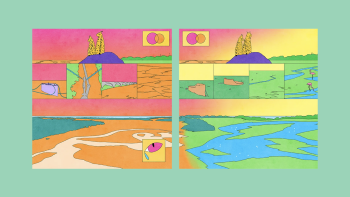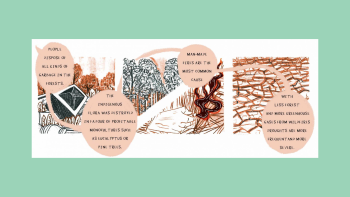|
→ View in browser
Over the past couple of years, I often got into discussions with friends on what we thought about recent pro climate actions such as soup-splattered masterpieces, activists glued to busy roads, or disrupted Wimbledon tennis matches. We argued about the level of disruption, the media coverage, the effectiveness of the message, and, ultimately, if we agreed or not.
Headline-grabbing protests capture attention, but the broader climate movement encompasses diverse tactics tailored to different communities and contexts. Indigenous communities in South America, Africa, and New Zealand are pursuing strategies to legally enshrine the rights of natural habitats. In 2008, Ecuador became the first country to grant nature the right to exist and regenerate in its constitution — while in 2024 the Klimaseniorinnen, a group of Swiss senior women, successfully brought their government to the European Court of Human Rights over inadequate climate action. And we cannot forget the young activists worldwide who continue organizing school strikes and youth-led lawsuits.
In our world of endless information and shrinking attention spans, some climate activists have turned to bold performances to pierce through the noise. And by some metrics, it's working. Research by the Social Change Lab demonstrates that these seemingly illogical acts generate significant media attention and boost active support through donations. Just Stop Oil, the UK group behind many headline-grabbing protests, achieved a concrete victory when the British government suspended new oil and gas licenses in 2023.
Yet these tactics simultaneously fuel considerable backlash, and the collateral damage falls on unamused everyday people. Museum staff scramble to check Van Gogh paintings for damage, commuters arrive late to work because of highway blockades, and tennis fans see their day of sipping Pimm's interrupted. Many public pollings reveals this tension; for example, in a 2023 research by the University of Bristol, 68% of respondents expressed disapproval of Just Stop Oil.
However, these strategies can have other positive ripple effects: it seems that the acts of radical groups help create consensus for more moderate groups — a phenomenon called “radical flank effect”. The extremes make milder approaches appear more reasonable by comparison, potentially expanding the overall climate movement's influence.
Regardless of whether we were in favor of or against disruptive tactics during those discussions with friends, they succeeded in bringing us to engage with and discuss climate policy in ways we might not have otherwise. Chapeau to all the activists who put themselves on the line to make that happen.
Sanjna
|
Read between the lines

|
Climate activists’ new, confrontational tactics aren’t popular. That’s kind of the point. — Kate Yoder, Grist (2022)
“2022 may be remembered as the year that climate protests got weird”. Here’s an overview of how disruptive tactics have, over the past few years, become a defining, if divisive, signature of climate activism.
|
|
|
The Last Generation’s Climate Rebellion — Jeffrey Arlo Brown, Noema Magazine (2023)
A recount of Germany’s The Last Generation activist group and how their trademark tactic, street blockades, began a culture war between 2021 and 2024.
|
|
|
What next for climate activism now Just Stop Oil is ‘hanging up the hi-vis’? — Matthew Taylor and Damien Gayle, The Guardian (2025)
A poll in 2023 showed that 64% of people disapproved of the actions of UK’s Just Stop Oil, and yet it is one of the most successful climate activism groups.
|
|
A collection of climate posters
Few images capture the mood of the 2020s better than the handmade signs at Fridays for Future marches, where climate urgency meets pop culture and internet humor.
|
In conversation with Nara
|
Some words by politician Nara Valsangiacomo, whose focus lies on sustainability, inequality and territorio [region or territory in Italian].
Q: What was your first experience with activism? And is there a particular climate demonstration or action that stands out as especially memorable to you?
I had always been sensitive about the climate around me, already from an early age. I remember setting up with a friend - at 10 or 11 years old - a stand with stickers and leaflets promoting shorter showers and switching to efficient light bulbs. And my father made some kind of a model to show how the greenhouse effect works.
I took part to various Klimastreiks [climate strikes in German] of different sizes around Switzerland. The Frauestreik [women's strike] on June 14th 2019 in Zurich was one of the first and largest manifestations I attended and it was amazing - it was mainly about feminism but environmental justice was also a topic. Two years ago I attended a large climate manifestation in Bern and it reminded me of being part of something way larger and recharged me for my work in my own region.
Q: How has the role of climate activism evolved and changed over the past years?
I see a shift from focusing on individual behaviors to emphasizing systemic issues and inequalities. Early activism often involved feelings of guilt over actions such as buying plastic-wrapped items or eating meat, but has since shifted to address the broader systemic challenges that limit individuals' sustainable choices, such as a lack of affordable public transportation.
I also see a fading of faith in institutions and in science. People have become very critical of everything and therefore require more direct communication. Personally, I have changed the way I talk about climate: I now use words that reconnect to people's direct surroundings and experiences. I talk about territorio [region or territory in Italian] - which has also an identity fling to it - rather than climate and about heat waves rather than rising temperatures. I mention the lack of trees or fresh water in a specific location. People see and feel directly that our summers have changed: much hotter days and pouring rains. And they connect with these words much more.
Q: Are there any cultural resources - think books, movies, documentaries, art - that helped shape the way you think about climate activism?
I loved My Octopus Teacher - it presents the richness of nature and its evolution over millenia. I got emotional thinking that now it is in danger. Biodiversity collapse is actually currently a much bigger threat than climate change.
During the Chiasso Letteraria festival, I discovered "Flora Ferroviaria" by Ernesto Schick, a book that explores and depicts the flora that grows along the rail infrastructure of Chiasso [Switzerland]. He traces the story of all these tiny plants and of the railways, which are such an important part of communication and mobility in Switzerland. Infrastructure took space away from nature, but then nature claimed it back.
|
|
Enjoying NOC? Your friends, family, community and colleagues might too. Here is a link for you to share this edition with them.
Link to this edition
|
Animated activism
|
Conscious comics — Min Heo, Cory Feder, Jer Dee and María Medem
Four comic artists illustrate four animals on the brink of extinction.
|

|
|
|
Epson — Katy Wang and Gabriel Greenough
The duo animate Gen Z’s feelings toward climate change, in a mixture of hope and fear.
|

|
|
|
A Short Tale Of Ash And Fire — Tânia Alexandra Cardoso
The comic artist recounts of forest fires in her native Portugal.
|

|
|
Ways to get inspired

Klimaseniorinnen
The 64+ years old Swiss women who brought the Swiss government to the European Court of Human rights.
|

Protect our Winters
The skiers and snowboarders fighting to protect their sport from global warming.
|

Sounds Right
Nature is now an official artist on Spotify and the royalties are funding conservation projects.
|
|
Through art
|
The Herds — The Walk Productions, directed by Amir Nizar Zuabi, 2025.
A herd of life-size animal puppets is marching from the Congo Basin to the Arctic Circle. In each country, local species are added to the troupe of cardboard animals.
|

|
Wheatfield – A Confrontation — Agnes Denes, 1982.
“I mean, can you imagine a wheat field in New York City?”. In the most urban setting possible, Denes’ challenged use of land by planting a field of wheat. To this day, it is one of the most iconic pieces of ecological public art.
|
The Bureau of Linguistical Reality — Alicia Escott and Heidi Quante, 2015-2025.
The duo work with communities to coin new words to help them describe experiences and emotions related to the climate crisis.
|
|
|
|
Our Picks

|
Chronotrains — a website that lets you find destinations you can reach by train from your city.
Dear Data — the postcard data art project by Giorgia Lupi and Stefanie Posavec.
Focus Friend — the concentration app with a knitting bean that surpassed ChatGPT and Google on the App Store.
One of Them Days — a comedy film about two friends and their race against the clock to avoid getting evicted.
The Boomerfication of Gen Z — a podcast episode that looks into the alleged similarities between Boomers and Gen Z.
Self Reliance — a comedy thriller where a man joins a deadly game where the only way to survive is never being alone.
|
|
|
NOC is a constant work-in-progress. We want to hear your thoughts, recommendations and ideas—reply to the newsletter via email or write to us on social media (LinkedIn or Instagram). Your input will help shape where we go next!
You can browse past editions on our website.
Was this email forwarded to you? You can register to our newsletter here.
One ask from us: to avoid our newsletter landing in your spam inbox, add our email address as a contact.
|
|